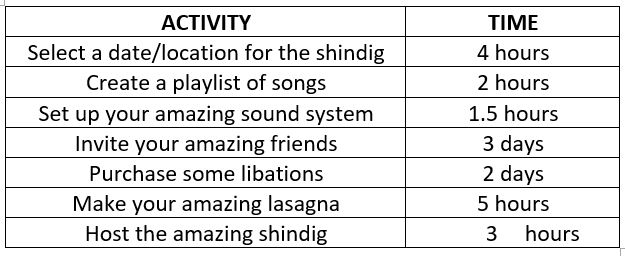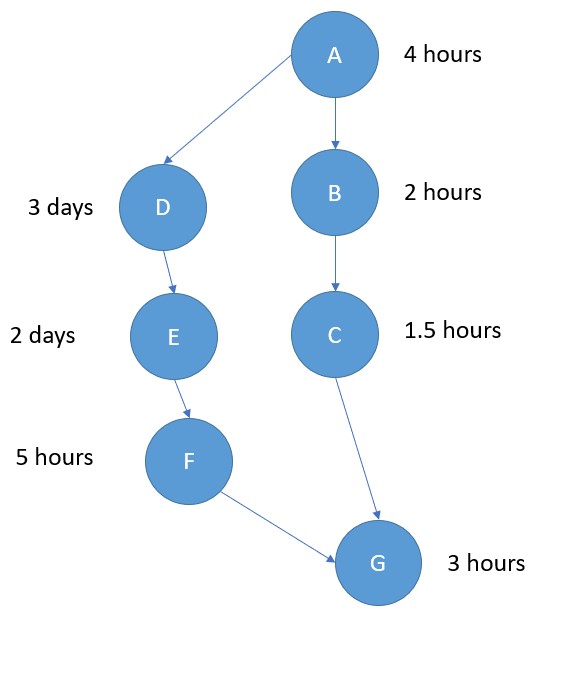This is What Flip Cup Taught Me About Critical Path
To some, “flip cup” may merely be a popular drinking game, but to me, it is a lot more than that – it is how I truly learned about a project management method called critical path…and I learned it the hard way! Before we get to critical path, let me first explain to those of you who aren’t familiar, how the game of flip cup works. Actually, I will illustrate the method by telling you a personal story.
Several years ago, me and a bunch of friends were tailgating before the big Miami-Florida State football game. Our tailgate included the usual cast of characters, as well as a ton of food and ahem…alcoholic beverages.
Being that it was a 5-hour tailgate…
…we needed an activity to keep us entertained. So, like many other tailgaters, we engaged in a friendly game of flip cup. Imagine if you will, 2 teams of 4 people each on 1 side of a rectangular table. Each person has a red plastic cup in front of them, half-filled with beer. After someone yells ‘Go!’, the first person on each team chugs their beer as fast as they can, then sets the cup back on the table standing up so that part of it is hanging over the side. They then use their finger to tap the bottom of the cup that is hanging over the edge so that it flips in the air and lands upside down on the table. Sometimes they do this on the first try, other times it takes a few tries. Once it successfully lands, the next person chugs their beer, and does the same thing, and so on until the last person on the team does it. So, you can think of it as a relay race and the team that finishes first wins.
The important concept to note is that each successive person cannot go until the previous person has gone – which while a simple example, explains the concept of critical path.

How did I learn about the importance of critical path the hard way during a game of flip cup? Well, of course, you will have to wait until the end of the blog post to find out!
First…
A Little Bit More About What the Critical Path Is…
The critical path method, or CPM as it is also known, is used in many engineering and project management disciplines. It is the longest path of planned activities from the start to the end of a project. Said another way, it is a series of steps that you need to take to complete a project which determines the shortest path to its completion.
It tells you which activities are critical (that need to be completed on time so as not to delay the project) and which activities are not critical (activities that can be delayed without making the project take longer). It also tells you which activities are dependent on each other.
Let’s Look at a Simple Example…
…to explain the concept of critical path a bit more. I am a creature of habit and make the same omelet every day for breakfast.
There are a few steps to making an omelet:
 Crack and beat the eggs
Crack and beat the eggs
 Heat and grease the pan
Heat and grease the pan
 Pour the eggs into the pan
Pour the eggs into the pan
 Add salt, veggies, and cheese
Add salt, veggies, and cheese
 Cook the omelet for 4 minutes
Cook the omelet for 4 minutes
Now if you look at those steps – not all of them are on the critical path. The critical path only contains the steps that are critical to completing the project, in this case, my omelet.
4 of the activities are critical to making the omelet, namely cracking and beating the eggs, heating and greasing the pan, pouring the eggs into the pan, and cooking the omelet for 4 minutes.
There is one activity – adding salt, veggies, and cheese – that is non-critical to making an omelet.
In other words, if I miss any of the critical activities, I WILL NOT have an omelet. But If I miss the non-critical activity, I WILL still have an omelet – it may suck and taste bland, but I will still have it. Meaning the critical activities are part of the critical path.
Before we look at a more detailed critical path example…
Let’s First Discuss the Steps Needed to Find the Critical Path
There are several steps that need to be taken to find the critical path:
(1) Define all the activities that must be completed as part of the project, and how long each will take.
(2) Figure out if any activities must be completed before any of the others.
(3) Create a network diagram which is just a graphical representation of the activities in sequential order as you will see in the example below.
(4) Figure out the critical path and how long it will take.
Another Example:
Say that you are planning a little shindig, and there are a bunch of activities that you need to complete for said shindig to go off without a hitch.
Let’s use the steps above to find the critical path…
(1) First, let’s list out the activities for the party and how long they take:

(2) Next, let’s figure out if any of the activities must be completed before any of the others by denoting which activity each activity is dependent on:

(3) Then, let’s create a network diagram…
…from the table above which connects circles representing each step along with the time needed for each step. Note the steps are in chronological order, and the steps they are dependent on are taken into consideration.

(4) Lastly, figure out the critical path and how long it will take:
In this case, there are 2 paths:
ABCG = (4 hours + 2 hours + 1.5 hours + 3 hours) = 10.5 hours
ADEFG = (4 hours + 3 days + 2 days + 5 hours + 3 hours) = 5 days and 12 hours
The critical path is the one that takes longer, in this case, it would not include activities B (creating a playlist of songs) and C (set up your amazing sound system) as they are not on the critical path – meaning you can do them any time.
So in this example, it would be ADEFG (the longer of the two) which means it would take approximately 5 days and 12 hours to complete the whole project.
Things to Keep in Mind…
While the critical path can get much more complicated than the examples above, there are a few key concepts to understand.
 By knowing the critical path:
By knowing the critical path:
You will know which activities if not completed on time will delay the entire project.
Conversely, you will know which non-critical activities, if not completed on time, will not delay the project.
 It is best to ask the who/what/when questions before you start the project because many times going back and adding activities results in both time and money costs.
It is best to ask the who/what/when questions before you start the project because many times going back and adding activities results in both time and money costs.
 You can shorten the critical path by:
You can shorten the critical path by:
 Getting rid of unnecessary critical path activities.
Getting rid of unnecessary critical path activities.
 Doing tasks at the same time if possible (in parallel)
Doing tasks at the same time if possible (in parallel)
 ‘Crashing the critical path’ – doing activities on the critical path faster.
‘Crashing the critical path’ – doing activities on the critical path faster.
Back to How I Learned About Critical Path the Hard Way!
So, there we were playing flip cup on a beautiful fall Miami day. The game itself goes pretty quick, usually, after a couple of minutes, one team wins. Which means you end up playing multiple games. As you can imagine when competition and alcohol are involved, there is a lot of trash talking. Well, after the 3rd or 4th game, I was talking a little bit too much smack and forgot to refill my cup. Anyway, the next game started and by the time it got to me, I realized ‘oh crap – my beer is empty!’. Unfortunately, by the time I had filled up my cup, the game was over.

My blunder of not filling up my cup was a key activity and due to it not being completed on time cost my team as the next person on my team could not go until I did due to the fact that…
I was part of the critical path!
Until next time, stay on the critical path, cheers and as always…PYMFP!
–Rick
If you enjoyed this post, it would mean the world to us if you shared it with people you care about via any of the social media platforms below!
Use it or Lose It: How to Find the Critical Path
There are several steps that need to be taken to find the critical path:
(1) Define all the activities that must be completed as part of the project, and how long each will take.
(2) Figure out if any activities must be completed before any of the others.
(3) Create a network diagram which is just a graphical representation of the activities in sequential order as you will see in the example below.
(4) Figure out the critical path and how long it will take.
When to Use It:
There are many places you can use the concept of critical path in your life:
 Doing things around the house – making coffee, cooking, doing chores and errands.
Doing things around the house – making coffee, cooking, doing chores and errands.
 Planning parties or events.
Planning parties or events.
 Completing household projects such as renovations.
Completing household projects such as renovations.
 Doing projects at work
Doing projects at work
 And many more
And many more
What Do You Think?
Have you used the concept of critical path in your life? Can you see yourself using it anywhere in your life? Please discuss in the comments below!
Popular Previous Posts:
12 Amazing Things I Learned from W. Edwards Deming
This is How to Boost Your Creativity Using Lateral Thinking!
12 Great Pieces of Life Advice from Old Steve Jobs Videos
How to Learn from Experiences With an After Action Review
Being Optimistic By Keeping Your Line in the Water!
References
https://hbr.org/1963/09/the-abcs-of-the-critical-path-method
https://web.stanford.edu/class/cee320/CEE320B/CPM.pdf
https://www.workamajig.com/blog/critical-path-method
https://www.coursera.org/lecture/scope-time-management-cost/critical-path-method-overview-hbzvb
https://www.slideshare.net/tutor2u/critical-path-analysis-10762045


Way back when, in the 80’s I learned about the critical path. Engineers use the critical path method constantly in figuring out schedules from project start to project finish. Identify each task, how long it takes (in hours, days, or weeks), what task immediately precedes it, and what task immediately follows it. We entered all this data into a computer, and a program automatically defined the critical path. We ten printed out the entire project schedule linearly on a dot matrix printer using fan-fold paper. The print out automatically highlighted the critical path, plus which tasks could be performed in parallel, tasks not on the critical path but had to wait until something else on the critical path had been completed, and items that were totally irrelevant to the path and could be accomplished at any time.
More often than not, the CP did not include items that you thought it should. The error was yours, not the machine’s. It forced you to re-evaluate – maybe a task’s duration was too long or too short, maybe a pre-requisite might be moved to earlier in the schedule, or maybe an item identified as being on the CP really did not belong. Your first attempt will always require tweakage. And quite often, your second and third attempts.
Hi Dave, I had a feeling you had some experience with critical path. I’ve used it similarly in both software development and industrial engineering type projects – and I agree, you definitely do tweak it as you go along. Thanks as always and have a fun weekend! Rick